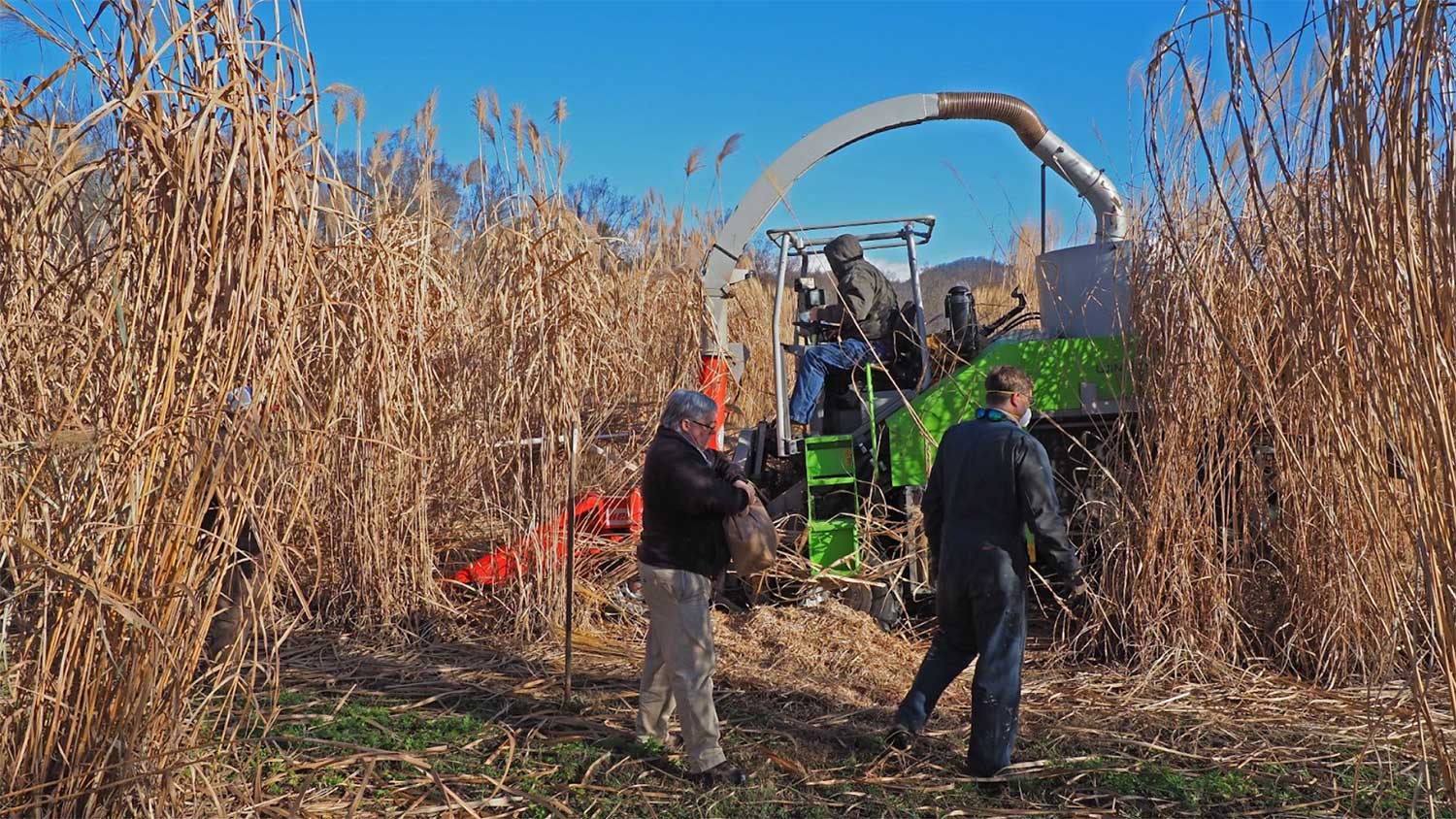Advancing Miscanthus: A Better Bioenergy Crop

JC Raulston Distinguished Professor Tom Ranney and the Mountain Crop Improvement (MCI) Lab have taken an interdisciplinary approach to improving giant miscanthus, sometimes called maiden grass, to develop optimal bioenergy traits adapted to North Carolina climates. This large Asian grass is an emerging biomass crop in the United States with an array of applications.
Successful bioenergy crops, like giant miscanthus, should maximize energy and biomass production per unit area; thrive on marginal land with minimal inputs; be highly adaptable to different soil types and resistant to pests; and have minimal environmental impacts. As new technologies emerge, the competitiveness and profitability of different bioenergy systems and fuel sources will continue to change. Therefore, it is important to start developing and producing transitional bioenergy crops that will have wide utility and value in diverse markets in both the near and long term.
Originally, the team’s giant miscanthus research was a spinoff from ornamental grasses for landscapes, but miscanthus has both landscape and bioenergy uses. Over the past 20 years, the MCI Lab has developed multiple generations of miscanthus hybrids that have optimal characteristics.
“We have released three, seedless triploid miscanthus for the landscape including My Fair Maiden™, Bandwidth,™ and High Frequency™”, says Ranney. “The work on bioenergy miscanthus focuses more on biomass yield, but are also triploids to prevent invasiveness. Our work on breeding miscanthus has been collaborative with many other faculty to evaluate production practices, agronomics, bioprocessing, biotechnology and commercialization.”
Allison Dickey, a fellow NC State Plant Breeding Consortium member and bioinformatician, began her analysis with the sequencing data.
“Identifying variants in the miscanthus samples was the first step in analyzing the sequencing data,” explains Dickey “The sequencing reads for the miscanthus samples were mapped to the Miscanthus sinensis reference genome. From there, variant calling was performed to identify single nucleotide polymorphisms (SNPs) and indels, and these variants could then be used in downstream analyses.”
The new giant miscanthus hybrids were created by combining tetraploid (Miscanthus sacchariflorus) and diploid (Miscanthus sinensis) to make new allotriploids. The new miscanthus has low fertility, which means it’s less likely to reseed or be invasive and spread like a weed. However, there isn’t much variety in existing triploid miscanthus, and not many efforts have been made to improve it. In a recent report, the new hybrid was compared with industry-standard (Miscanthus ×giganteus ‘1993-1780’). After four years, the new grass hybrids produced more dried plant material, known as biomass. When analyzing the genetic characteristics, the new hybrid grasses had better biofuel traits compared to the well-known cultivars. Investigating the genes of the new perennial grass also revealed that the grasses have greater genetic diversity than existing miscanthus crops.
New Energy Farms has partnered with the MCI Lab to test advanced selections and commercialize them throughout the European Union and potentially the United States. With momentum building for miscanthus, Ranney sat down to reflect on the significance of the MCI Lab’s research and what it means for the future.
Why are biomass yields, reproductive fertility, compositional analysis, and genetic diversity improvements important?
These are all important traits. Yield is paramount for bioenergy crops to maximize profitability. We don’t want to introduce weeds, so low fertility is important. Optimizing the compositional analysis for different applications makes them more suitable for various applications. And, you want broad genetic diversity in your crop to avoid monocultures. Previously, people were largely growing just one clone of giant miscanthus.
Where have you seen greater demand for bioenergy crops and their uses?
Bioenergy is still an emerging sector. In the United States, bioenergy grasses are used mostly for animal bedding, erosion prevention mats, and fiber products like nursery containers and oriented strand boards. Currently, the greatest demand is in the European Union where they are burned for electrical power generation. Cellulosic ethanol has yet to become a major player.
Has there been an increase in biofuel demands since establishing the program?
Yes, but not like we thought. When we started the focus was on cellulosic ethanol production and we were funded by companies like BP. As those markets failed to materialize, we shifted to more diversified applications of biomass.
Are there any challenges or lessons learned from researching giant miscanthus hybrids?
To me, this was a great example of the power of conventional plant breeding. Starting with wild-type miscanthus, we used a simple and age-old approach of recurrent selection, coupled with ploidy manipulation to develop these varieties. In the span of a few years, we were able to increase yields by 60% compared to existing industry standards. Now that we have pushed those goals with conventional breeding, we are exploring additional value-added enhancements using biotechnology approaches in collaboration with other NC State faculty.
Want more leadership in horticulture research?
Emerging research in the Department of Horticultural Science impacts growers, industry, students and everyday North Carolinians through cutting-edge research programs. Follow how our discoveries affect agriculture and the environment by joining our monthly newsletter.
For a hands-on academic path that provides real-world benefits and applications explore our undergraduate and graduate programs to learn from expert faculty and have career-focused experiences.
Training future ag leaders is part of how we are advancing plants.
- Categories:


